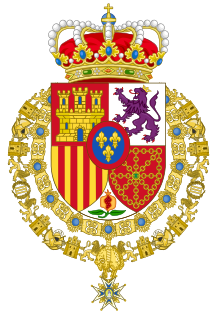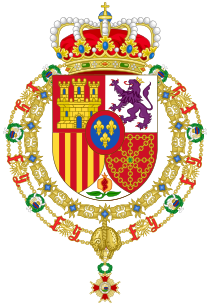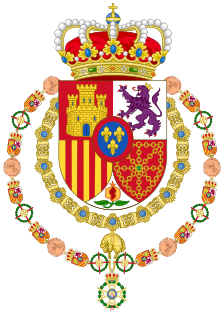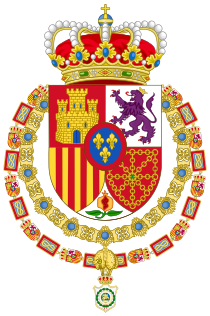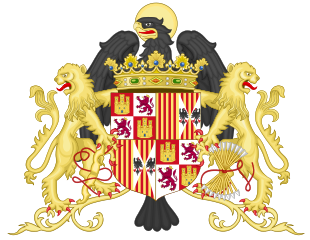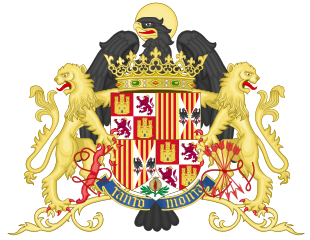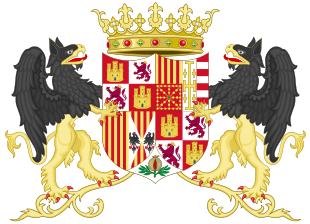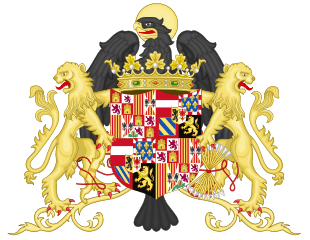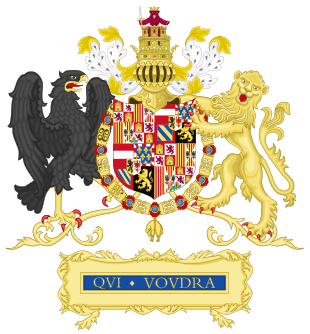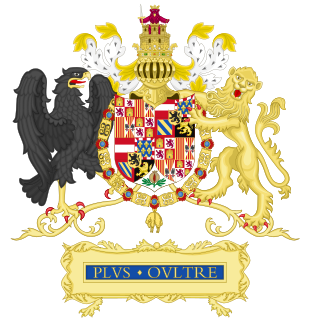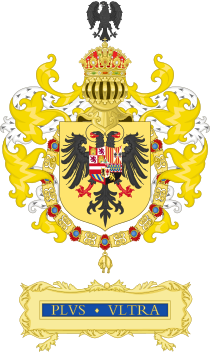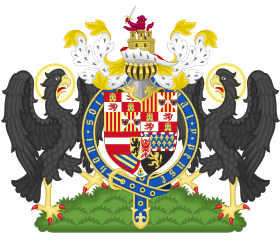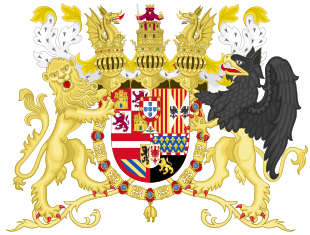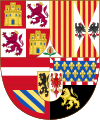Coat of arms of the King of Spain facts for kids
Quick facts for kids Coat of arms of the King of Spain |
|
|---|---|
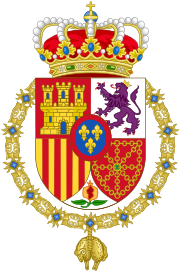 |
|
| Armiger | Felipe VI |
| Adopted | 19 June 2014 |
| Crest | Spanish Royal Crown |
| Blazon | Quarterly: Castile, León, Aragon, and Navarre; enté en point: Granada; inescutcheon Bourbon (Anjou Branch) |
| Order(s) | Order of the Golden Fleece |
| Earlier version(s) | See below |
The coat of arms of the King of Spain is a special symbol that represents the Spanish monarch. Think of it like a unique badge for the King! The design we see today was officially adopted in 2014. However, its roots go back a very long time.
This coat of arms combines symbols from old kingdoms that make up Spain. These include the kingdoms of Castile, León, Aragon, and Navarre.
In the past, coats of arms belonged to the kings and queens, not to the whole country. Monarchs would often combine symbols from all the lands they ruled. The old Spanish royal arms used to be much more detailed than they are now. They showed symbols from many different territories that the royal family controlled.
In 1868, after Queen Isabella II was removed from power, a new "national" coat of arms was created. This new design set up the way the main symbols are arranged on the shield today. When the monarchy returned, both the "national" and "royal" arms were used. In 1931, the "national arms" became the royal arms, but the monarchy was soon ended that same year.
When Juan Carlos, the grandson of the last king, was chosen to become king in 1975, he used a coat of arms that looked very similar to the current one. When his son, Felipe VI, became king in 2014, some parts were removed from the royal arms to make them simpler.
Contents
What the Coat of Arms Looks Like (Blazon)
The official description of the King of Spain's coat of arms is found in a special law from 2014. This law was made when King Felipe VI became king.
The main part of the coat of arms is a shield divided into four sections. Here's what each section shows:
- The first section (top left) is red (called gules). It has a gold (or) castle with three towers. This represents the old Kingdom of Castile.
- The second section (top right) is silver (argent). It shows a purple (purpure) lion standing on its hind legs, wearing a gold crown. This is for the Kingdom of León.
- The third section (bottom left) is gold. It has four red stripes (pallets). This stands for the Crown of Aragon.
- The fourth section (bottom right) is red. It has a golden cross and chains linked together. This is the symbol for the Kingdom of Navarre.
At the very bottom of the shield, there's a small pointed section that is silver. It shows a pomegranate fruit with green leaves. This represents Granada, a region in Spain.
In the very center of the shield, there's a small blue (azure) shield with a red border (bordure). Inside it are three gold fleurs-de-lys (a stylized lily flower). This symbol belongs to the Bourbon-Anjou family, which is the royal family of Spain.
Around the whole shield is the special collar of the Order of the Golden Fleece. This is a very old and important award. On top of the shield is the royal crown of Spain. It is made of gold and jewels, with eight arches that meet at the top under a cross and a globe.
From 1971 to 1975, when Juan Carlos was Prince of Spain, his coat of arms was almost the same. The only difference was the crown, which was a "Crown Prince" crown with fewer arches. His arms also included a red cross (called the Cross of Burgundy) and symbols used by the Catholic Monarchs: a yoke and a bundle of five arrows. When Felipe VI became king in 2014, these extra symbols were removed.
Different Versions (Variants)
Sometimes, the King's coat of arms looks a little different. This happens when the King is also the leader (Grand Master) of certain important Spanish orders of knighthood. The main shield stays the same, but the collar around it changes to show the symbols of that specific order.
| Variants of the coat of arms of the King of Spain | |||
|---|---|---|---|
| Variant as Grand Master of the Order of Charles III Surrounded by the collar of this order |
Variant as Grand Master of the Order of Isabella the Catholic Surrounded by the collar of this order |
Variant as Grand Master of the Order of Saint Ferdinand Surrounded by the grand master's collar |
Variant as Grand Master of the Order of Saint Hermenegild Surrounded by the grand master's collar of this order |
Historical Royal Coats of Arms
The Spanish royal coat of arms has changed many times throughout history. Each royal family added their own symbols or changed the design. Here are some examples of how the royal arms looked for different monarchs:
| Royal Arms | Monarch | Key Features |
|---|---|---|
| House of Trastámara (1475–1506) | ||
| The Catholic Monarchs (1474–1492) |
Included two lions and the Eagle of St John. | |
| The Catholic Monarchs (1492–1504) |
Added a yoke and a sheaf of five arrows. | |
| Ferdinand II of Aragon (1504–1516) |
Featured two griffins as supporters. | |
| Joanna of Castile (1504–1506) |
Used the Eagle of St John and two lions. | |
| Philip I of Castile (1504–1506) |
Included the Order of the Golden Fleece. | |
| House of Habsburg (1506–1700) | ||
| Charles I (1506–1520) |
Featured the Order of the Golden Fleece and the motto Plus ultra (Further beyond). | |
| Charles I as Holy Roman Emperor (1530-1556) |
Sometimes showed a double-headed eagle. | |
| Philip II (1554-1558) |
As King of England, it included the Order of the Garter. | |
|
|
Philip II to Charles II (1580-1668) |
Often had one lion and one griffin as supporters. |
| House of Bourbon (1700–1808 / 1813–1868 / 1874–1931 / 1975–present) | ||
| Philip V to Charles III (1700-1761) |
Included two angels, the Pillars of Hercules, and the Order of the Holy Spirit. | |
| Charles III to Alfonso XIII (1761-1931) |
Similar to the previous, also featuring the Order of Charles III. | |
| Juan Carlos I (1975) |
Included the Cross of Burgundy, the Order of the Golden Fleece, a yoke, and a sheaf of five arrows. | |
| French occupation (1808–1813) | ||
| Joseph Bonaparte (1808–1813) |
Featured two sceptres and the Legion of Honour. | |
| House of Savoy (1870–1873) | ||
| Amadeus (1870–1873) |
A simpler design with the modern royal crown and the Order of the Golden Fleece. | |
See also
 In Spanish: Escudo de armas del rey de España para niños
In Spanish: Escudo de armas del rey de España para niños


